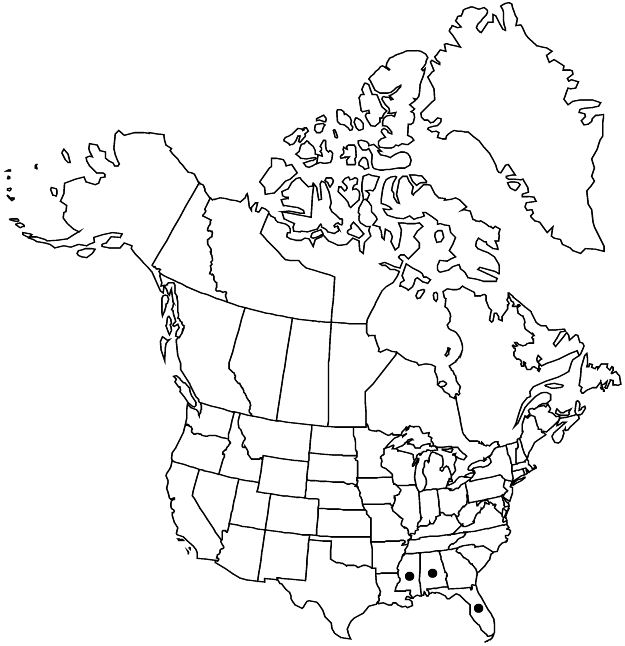Difference between revisions of "Crocanthemum arenicola"
in J. K. Small, Man. S.E. Fl., 879. 1933.
FNA>Volume Importer |
imported>Volume Importer |
||
| (5 intermediate revisions by 2 users not shown) | |||
| Line 1: | Line 1: | ||
{{Treatment/ID | {{Treatment/ID | ||
|accepted_name=Crocanthemum arenicola | |accepted_name=Crocanthemum arenicola | ||
| − | |accepted_authority=(Chapman) Barnhart | + | |accepted_authority=(Chapman) Barnhart |
|publications={{Treatment/Publication | |publications={{Treatment/Publication | ||
|title=in J. K. Small, Man. S.E. Fl., | |title=in J. K. Small, Man. S.E. Fl., | ||
| Line 12: | Line 12: | ||
|label=Endemic | |label=Endemic | ||
}} | }} | ||
| − | |basionyms={{Treatment/ID/ | + | |basionyms={{Treatment/ID/Basionym |
|name=Helianthemum arenicola | |name=Helianthemum arenicola | ||
|authority=Chapman | |authority=Chapman | ||
| + | |rank=species | ||
| + | |publication_title=Fl. South. U.S., | ||
| + | |publication_place=35. 1860 | ||
}} | }} | ||
|synonyms= | |synonyms= | ||
| Line 40: | Line 43: | ||
-->{{#Taxon: | -->{{#Taxon: | ||
name=Crocanthemum arenicola | name=Crocanthemum arenicola | ||
| − | + | |authority=(Chapman) Barnhart | |
| − | |authority=(Chapman) Barnhart | ||
|rank=species | |rank=species | ||
|parent rank=genus | |parent rank=genus | ||
| Line 55: | Line 57: | ||
|publication year=1933 | |publication year=1933 | ||
|special status=Endemic | |special status=Endemic | ||
| − | |source xml=https:// | + | |source xml=https://bitbucket.org/aafc-mbb/fna-data-curation/src/2e0870ddd59836b60bcf96646a41e87ea5a5943a/coarse_grained_fna_xml/V6/V6_759.xml |
|genus=Crocanthemum | |genus=Crocanthemum | ||
|species=Crocanthemum arenicola | |species=Crocanthemum arenicola | ||
Latest revision as of 22:23, 5 November 2020
Herbs. Stems ascending or spreading to erect, 5–15(–20) cm, stellate-pubescent. Leaves cauline; petiole 0.5–2 mm; blade oblanceolate to lanceolate, 8–20(–28) × 2–4(–10) mm, surfaces stellate-tomentose abaxially, stellate-pubescent adaxially, lateral veins obscure abaxially. Inflorescences usually terminal, sometimes lateral, umbellate; chasmogamous flowers 2–10 per umbel; cleistogamous 2–10 per umbel. Pedicels (2.5–)5–10(–15) mm; bracts 1–3.5 × 0.3–0.6 mm. Chasmogamous flowers: outer sepals linear, 2–4 × 0.5 mm, inner sepals 4–8 × 3.5–4.8 mm, apex acute; petals obovate, 8–9.5 × 7.5–9 mm; capsules 3-valved, 3.6–5.4 × 2.4–3.6 mm, stellate-pubescent distally. Cleistogamous flowers: outer sepals linear, 1–2 × 0.4 mm, inner sepals ovate, 3.6–5.6 × 2.2–2.8 mm, apex acute; capsules 3–4.6 × 2.4–3.4 mm, stellate-pubescent distally.
Phenology: Flowering Mar–Apr.
Habitat: Maritime sand dunes and interdunes among pine-oak scrub
Elevation: 0–10 m
Distribution

Ala., Fla., Miss.
Discussion
Crocanthemum arenicola occurs in 11 contiguous counties, from Franklin in Florida to Harrison in Mississippi. Only C. arenicola and C. nashii possess stellate-pubescent ovaries and capsules; they are allopatric, occupy different habitats, and present no identification difficulties.
Selected References
None.